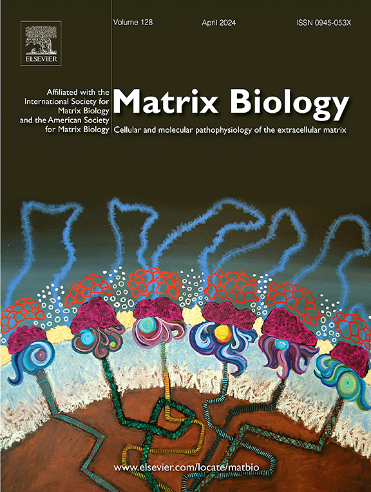胶原IV型生物合成:翻译后修饰的细胞内编排。
IF 4.5
1区 生物学
Q1 BIOCHEMISTRY & MOLECULAR BIOLOGY
引用次数: 0
摘要
IV型胶原是一种重要的、进化上保守的基底膜成分,是最广泛的翻译后修饰蛋白之一。尽管对纤维性胶原的生物合成进行了大量的研究,但我们对IV型胶原的生物合成,包括其翻译后修饰(PTMs)的了解仍然有限。大多数PTMs发生在细胞内,主要发生在内质网(ER)内。在这篇综述中,我们研究了内质网中协调IV型胶原生物合成的分子集合,强调了脯氨酸和赖氨酸羟化酶、糖基转移酶和分子伴侣之间的复杂相互作用。此外,我们还讨论了IV型胶原及其PTMs中的缺陷如何导致各种人类病理,包括Gould和Alport综合征、纤维化和癌症。了解胶原IV型PTMs对于阐明这些疾病的分子基础和改善靶向治疗至关重要。通过回顾我们对IV型胶原蛋白生物合成的了解,我们说明了这种进化上保守但高度特化的分子生物合成合体如何支持IV型胶原蛋白在健康和疾病中的多种功能。本文章由计算机程序翻译,如有差异,请以英文原文为准。
Collagen IV biosynthesis: Intracellular choreography of post-translational modifications
Collagen IV, an essential and evolutionarily conserved component of basement membranes, is one of the most extensively post-translationally modified proteins. Despite substantial research on fibrillar collagen biosynthesis, our understanding of collagen IV biosynthesis, including its post-translational modifications (PTMs), remains limited. Most PTMs occur intracellularly, primarily within the endoplasmic reticulum (ER). In this review, we examine the molecular ensemble that orchestrates collagen IV biosynthesis in the ER, highlighting the complex interplay between prolyl and lysyl hydroxylases, glycosyltransferases, and molecular chaperones. Furthermore, we discuss how defects in collagen IV and its PTMs contribute to various human pathologies, including Gould and Alport syndromes, fibrosis, and cancer. Understanding collagen IV PTMs is crucial for elucidating the molecular basis of these diseases and improving targeted treatments. By reviewing our knowledge of collagen IV biosynthesis, we illustrate how this evolutionarily conserved yet highly specialized molecular biosynthesis ensemble supports the diverse functions of collagen IV in health and disease.
求助全文
通过发布文献求助,成功后即可免费获取论文全文。
去求助
来源期刊

Matrix Biology
生物-生化与分子生物学
CiteScore
11.40
自引率
4.30%
发文量
77
审稿时长
45 days
期刊介绍:
Matrix Biology (established in 1980 as Collagen and Related Research) is a cutting-edge journal that is devoted to publishing the latest results in matrix biology research. We welcome articles that reside at the nexus of understanding the cellular and molecular pathophysiology of the extracellular matrix. Matrix Biology focusses on solving elusive questions, opening new avenues of thought and discovery, and challenging longstanding biological paradigms.
 求助内容:
求助内容: 应助结果提醒方式:
应助结果提醒方式:


